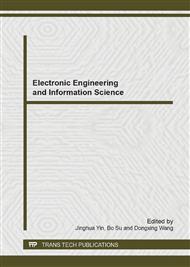p.255
p.258
p.262
p.267
p.275
p.279
p.287
p.295
p.299
Based on Non-Redundant Electronic Scale Engineering Development Theory
Abstract:
This paper regards combinatorial techniques for electronic engineering design based on the mathematical apparatus of Non Redundant Scales theory (NRS theory).Combinatorial techniques is known to be of widespread applicability, and has been extremely effective when applied to the problem of finding the optimum ordered arrangement of structural elements in spatially or temporally distributed systems with non-uniform structure (e.g. line gages) with respect to resolving ability. These design techniques make it possible to configure electronic devices or systems with fever elements than at present, while maintaining on resolving ability and positioning precision. The NRS theory can be used to finding optimal design for wide classes of technological problems in measurement and radio electronic engineering based on combinatorial techniques.
Info:
Periodical:
Pages:
275-278
Citation:
Online since:
July 2014
Price:
Сopyright:
© 2014 Trans Tech Publications Ltd. All Rights Reserved
Share:
Citation:


